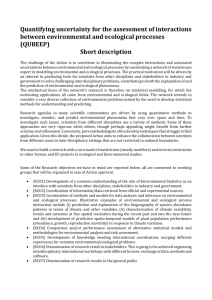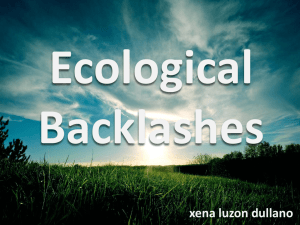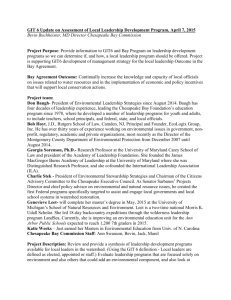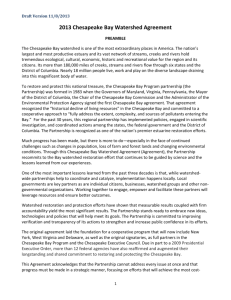Stac meeting - discussion notes
advertisement
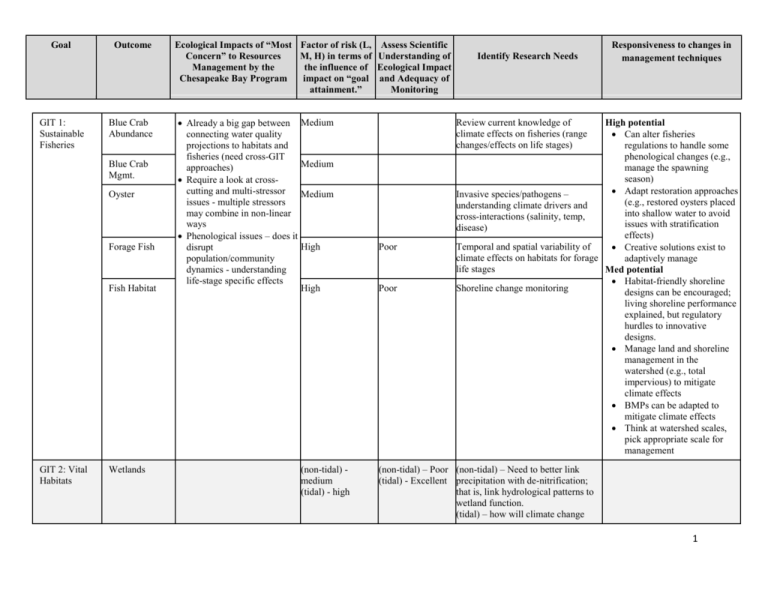
Goal GIT 1: Sustainable Fisheries Outcome Blue Crab Abundance Blue Crab Mgmt. Oyster Forage Fish Fish Habitat GIT 2: Vital Habitats Wetlands Ecological Impacts of “Most Factor of risk (L, Concern” to Resources M, H) in terms of Management by the the influence of Chesapeake Bay Program impact on “goal attainment.” Already a big gap between connecting water quality projections to habitats and fisheries (need cross-GIT approaches) Require a look at crosscutting and multi-stressor issues - multiple stressors may combine in non-linear ways Phenological issues – does it disrupt population/community dynamics - understanding life-stage specific effects Assess Scientific Understanding of Ecological Impact and Adequacy of Monitoring Medium Identify Research Needs Responsiveness to changes in management techniques Review current knowledge of climate effects on fisheries (range changes/effects on life stages) Medium Medium High potential Can alter fisheries regulations to handle some phenological changes (e.g., manage the spawning season) Adapt restoration approaches Invasive species/pathogens – (e.g., restored oysters placed understanding climate drivers and into shallow water to avoid cross-interactions (salinity, temp, issues with stratification disease) effects) Temporal and spatial variability of Creative solutions exist to climate effects on habitats for forage adaptively manage life stages Med potential Habitat-friendly shoreline Shoreline change monitoring designs can be encouraged; living shoreline performance explained, but regulatory hurdles to innovative designs. Manage land and shoreline management in the watershed (e.g., total impervious) to mitigate climate effects BMPs can be adapted to mitigate climate effects Think at watershed scales, pick appropriate scale for management High Poor High Poor (non-tidal) medium (tidal) - high (non-tidal) – Poor (non-tidal) – Need to better link (tidal) - Excellent precipitation with de-nitrification; that is, link hydrological patterns to wetland function. (tidal) – how will climate change 1 Goal Outcome Ecological Impacts of “Most Factor of risk (L, Concern” to Resources M, H) in terms of Management by the the influence of Chesapeake Bay Program impact on “goal attainment.” Assess Scientific Understanding of Ecological Impact and Adequacy of Monitoring Identify Research Needs Responsiveness to changes in management techniques facilitate invasive species Black Duck black duck select Chesapeake bay due to habitat but food source will change due to climate change and migration patterns may also change High Poor Stream Health Climate Change impacts High (with functional pyramid; urban uncertainty) runoff; subsidence may change flow and source for stream; recurrent flooding will increase run off; saturated earth will increase failure of low-buried urban infrastructure such as sewerage and oil lines, which are already aging. Poor Brook Trout Dry streams and temperature High change impact food. New temp ranges puts Brook Trout into competition with other species Fair Fish Passage Climate change may impact the Medium-Low effectiveness of fish passage projects in mitigation or conditioning the health of the Bay environment (e.g., opening dams; stranding and low-flow events) Excellent Submerged Aquatic Veg. Increase SLR implies increased High hardening shoreline implies decrease eelgrass; eelgrass in saltwater tolerant; when eelgrass disappears this means Excellent Need to assess “high marsh habitat condition”; need to map habitat How sensitive are species to temperature change? What conservation strategies will work? 2 Goal Outcome Ecological Impacts of “Most Factor of risk (L, Concern” to Resources M, H) in terms of Management by the the influence of Chesapeake Bay Program impact on “goal attainment.” Assess Scientific Understanding of Ecological Impact and Adequacy of Monitoring Identify Research Needs Responsiveness to changes in management techniques change in sheltering and food GIT 3: Water Quality Forest Buffer Climate change may impact the Medium-High effectiveness of forest buffers in mitigating or conditioning the health of the Bay environment. Fair Tree Canopy Climate change may impact the Medium-Low effectiveness of tree canopy in mitigating or conditioning the health of the Bay environment. Fair 2017 WIP Outcome Low Poor How do climate change concerns drive behavioral changes that impact water quality Investigate impacts on increasing irrigation/drainage (flows, fluxes, land subsidence) Climate impacts on crop rotation and disease pressure. Changes in these may impact recommended BMPs and then there is a need to assess and evaluate the effectiveness of recommended BMPs that may need to/have been adapted to address a new climate reality. 2025 WIP Outcome Medium Poor (uncertainty about how stakeholders will respond to uncertainty about climate change and adaptation to climate change) Design and function of BMPs under new climate reality (i.e. larger, more frequent storm events) Need to develop BMP implementation guidelines that are outcome oriented rather than focused on meeting specific 3 Goal Outcome Ecological Impacts of “Most Factor of risk (L, Concern” to Resources M, H) in terms of Management by the the influence of Chesapeake Bay Program impact on “goal attainment.” Assess Scientific Understanding of Ecological Impact and Adequacy of Monitoring Identify Research Needs Responsiveness to changes in management techniques target dates or implementation milestones Water Quality Standards Attainment and Monitoring High (longer term) (Uncertainty about BMP functionality under and altered climate regime and uncertainty about behavior, e.g. changing crop rotations, increase irrigation/drainage, changing development patterns) Poor (lack of Need for scoping studies that clarity on how/if take a given climate scenario BMPs called for on forecast and examine WIPs will function consequences of alternate as intended. This behavioral (management) uncertainty is scenarios. present at multiple Continually reassess/reprioritize scales from field to monitoring schemes to ensure watershed) that monitoring considers climate change reality. Need for more, higher resolution (in both space and time) monitoring, especially characterizing the impact of larger magnitude events. Investigate impact of intensifying animal agriculture in the context of climate change (e.g., higher temps will require more ventilation for poultry operation; how will this impact loads from emissions. High resolution analysis of change at various scales across systems. 4 Goal Outcome Ecological Impacts of “Most Factor of risk (L, Concern” to Resources M, H) in terms of Management by the the influence of Chesapeake Bay Program impact on “goal attainment.” Assess Scientific Understanding of Ecological Impact and Adequacy of Monitoring Identify Research Needs Responsiveness to changes in management techniques General comments: Productive ag part of a healthy watershed. Mgmt. opportunity to moderate is low and all a matter of scale. Stream and wetlands are indicators of healthy watersheds. Healthy Waters Outcome Temperature (urban) Assumption was that temperature was going to increase. GIT 4: Healthy Watersheds Low vulnerability because urban temperature signature overwhelms what we get from the natural system General (not climate impact specific): Ground and surface water interaction. Small scale watershed monitoring Link between management and system response Increases in shading, diminish urban E dial, surface water, etc. There is an ability to manage the landscape to reduce the vulnerability. Temperature (rural) - Forest health (canopy changes) and an element in overall watershed health. Increase stream shading, improve cold water habitats in upland systems. Precipitation: Seasonality (urban) Retrofit streams (expand floodplain), reduce flooding frequency, moderating peak flows. High mitigation increase would have high impact on aquatic ecosystem health. 5 Goal Outcome Ecological Impacts of “Most Factor of risk (L, Concern” to Resources M, H) in terms of Management by the the influence of Chesapeake Bay Program impact on “goal attainment.” Assess Scientific Understanding of Ecological Impact and Adequacy of Monitoring Identify Research Needs Responsiveness to changes in management techniques Precipitation: Seasonality (rural) Modest – Ag BMP implementation (edge of field practices) and scale of watersheds is increase as you move towards rural systems. Capacity to make a difference is better in smaller watersheds but as you scale up, there is less. Negative - drainage in winter and irrigation in summer. Rainfall intensity bigger in urban. Increase intensity in warm weather. Retention and infiltration Rainfall intensity (rural) – little more capacity to manage. Timing matters. Sea Level Rise –mainly coastal No mitigation options 6




